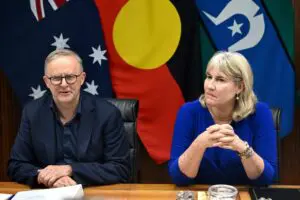The South Australian government is bucking the trend in other states to introduce a higher “fair” feed-in tariff (FIT) for solar system owners who are feeding excess electricity back in to the grid.
Instead the focus is on storage, and lots of it, according to energy minister and Treasurer, Tom Koutsantonis, speaking at an industry Solar Roundtable event last Friday held by The Solar Project.
He argued that South Australia’s success versus other mainland states in its transition over to renewables meant the focus in South Australia now has to be different.
With 53 per cent of the state’s electricity last year coming from solar and wind – smashing through the 50 per cent target 8 years ahead of schedule – the focus in the state has to be on making all this clean energy more ‘despatchable’, that is, having it more controlled as to when it is released to the grid.
That comes down to one word – storage – as the new focus.
Koutsantonis said that increasing the FIT would simply reduce the financial incentive for home and business owners to add storage to their premises.
The focus of the government is no longer to encourage more solar and wind to be installed – that is happening now irrespective of any FITs and other state encouragements due to the record low prices for installations – but to kick start more storage to be installed across the grid and to have this storage managed in order to smooth out the variability of supply and demand.
Given recent Deutsche Bank forecasts that South Australia could hit 95 per cent from renewables within just a decade, adding more storage becomes a key priority.
The storage sought is to include large centralised units, such as the SA government’s tender for a 100MW/100MWh system for installation this year – which will be the largest in Australia if not the world – plus he listed also pumped hydro and solar thermal plants with their alternate storage mechanisms.
However, as important to the state is to add batteries to the tens of thousands of homes and businesses in South Australia that have only solar installed currently.
When asked about the AGL and SAPN Virtual Power Plants that are being created – using subsidized batteries installed at over 1,000 solar equipped homes across Adelaide – and whether there are any plans to extend this to more home and business owners, Koutsantonis replied that while he couldn’t pre-empt what will be in the state budget, there might be some encouragement announced to have more such battery systems installed across the state.
Surprisingly there was almost no talk by the Treasurer about gas being a despatchable energy source for the state.
Instead the focus in his answers was on the ability of batteries, pumped hydro and solar thermal to not only be despatchable, but also to do frequency control and other grid stabilisation. He noted at length that batteries in particular can respond in milliseconds, something that large mechanical turbines can not do.
Finally, the questioning turned to electric vehicles (EVs), and one EV owner said that during a recent tour of South Australia Power Networks’Network Innovations Centre, he asked about the ability to use his car’s battery to feed in power to the grid when his car is sitting at home or at work during times of high demand.
He was told it was expressly disallowed by SAPN personnel as it might destabilise the grid. This was a surprise since other high renewable use countries like Germany are encouraging the adoption of EVs explicitly to help quickly add more storage into the grid in a more cost-effective way compared to just installing static home storage systems that could use the batteries for just the one purpose.
Koutsantonis replied that he is working to make sure SAPN and other companies remove these kinds of restrictions and questioned whether the grid operators and power companies had these restrictions for just technical reasons alone or used it more as an excuse to retain their monopolistic profits as long as they could.
He said he wants in fact many more electric – and hydrogen – vehicles in the state – to make use of the upcoming large new capacities of lower-cost solar and wind power being installed in the state and reduce transport costs for South Australians.
He noted that already today travelling by EVs was much cheaper per kilometre than using petrol or diesel, despite today’s still high electricity tariffs.
Being able to sell excess power from the EV batteries to the grid when needed can be an extra source of incomes for families and therefore should be not only be allowed but encouraged.
He went further in conclusion to describe the ideal arrangement in South Australia where an electricity bill eventually switches from being a dreaded burden or ‘debt’ on homes and businesses each month to being an ‘asset’.
That is, in future all South Australians will also be able to also earn money by being connected to the grid – supplying power and storage, thus spreading the wealth away from just the handful of multinationals who today charge high prices and make huge profits from a lack of competition in the market.
So, in short for South Australia, it is a big no to higher FITs, and a big yes to more storage and EVs in the years ahead.











